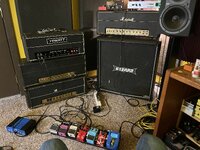Bxlxaxkxe
Amp ho
Anyone who says these amps sound the same has some of the worst ears in the history of guitar tone. Sure, they’re very similar in some ways, but they’re also so incredible different when you’re behind the wheel.
JCM800: Brighter, tighter, more pokey and aggressive
JMP: Saggier, fuller, somewhat dull high end comparatively
I actually think the JCM800 2204 sounds more like a JMP2203 than the 800 2203 does. Little more give to the feel, little more saturation (or appearance of it), but still a more articulate and bright version.
Boosting gets them more in the same ballpark. Straight in, I’ll take the 2204 for sure. Once boosted, it gets a lot harder to pick and is more about what the riff calls for
JCM800: Brighter, tighter, more pokey and aggressive
JMP: Saggier, fuller, somewhat dull high end comparatively
I actually think the JCM800 2204 sounds more like a JMP2203 than the 800 2203 does. Little more give to the feel, little more saturation (or appearance of it), but still a more articulate and bright version.
Boosting gets them more in the same ballpark. Straight in, I’ll take the 2204 for sure. Once boosted, it gets a lot harder to pick and is more about what the riff calls for

